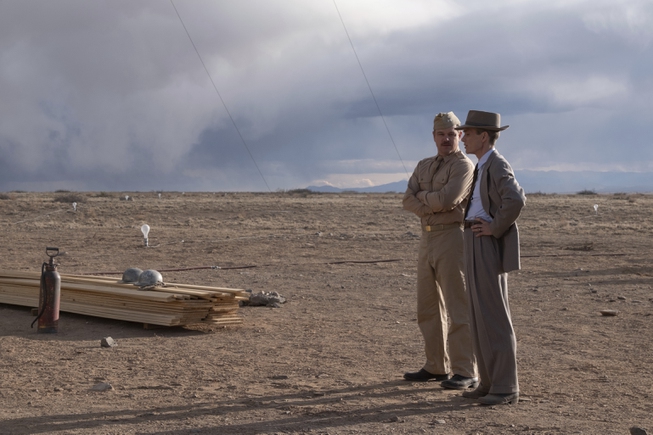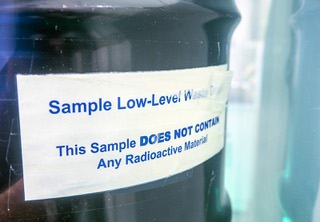
Universal Pictures via AP
Matt Damon as Gen. Leslie Groves, left, and Cillian Murphy as J. Robert Oppenheimer are shown in a scene from “Oppenheimer,” which opens nationwide today. The biopic about the so-called father of the atomic bomb is likely to spark interest among Southern Nevadans because of the area’s rich history during the Atomic Age.
Friday, July 21, 2023 | 2 a.m.
Robert McCoy remembers as a kid growing up in Las Vegas the suspense of waiting for an underground nuclear weapon test to occur.
The biggest one he can recall happened while he sat in class at Robert O. Gibson Junior High School on West Washington Avenue, where a countdown sounded over the school intercom and was followed by the rippling of his classroom floor only 30 seconds later, the effects of a test at the Nevada Test Site.
And while most children in Nevada today may not know of or feel these tests, director Christopher Nolan’s new movie, “Oppenheimer,” is expected to reignite conversations on the Atomic Age. The film opens nationwide today.
The World War II-era drama starring Irish actor Cillian Murphy follows the life of J. Robert Oppenheimer, who is largely credited for leading the team of scientists who created the atomic bomb. Hollywood Reporter reports the film is projected to pull in about $49 million this weekend.
“It was an interesting time to live through here in Nevada,” said McCoy, CEO of the National Atomic Testing Museum. “This movie, I think, really has ignited a perhaps new debate over the atomic conversation on the atomic world, and we’re happy that it is because we want to have that conversation.”
US develops nuclear arsenal
Nevada holds an important place in the history of atomic weaponry and its testing despite the first nuclear explosion occurring in Los Alamos, N.M., where the atomic bomb was developed during a top-secret mission. The primary sites of the bomb’s development — Los Alamos; Hanford, Wash.; and Oak Ridge, Tenn., have since been preserved as historic parks by the National Park Service and U.S. Department of Energy.
The story behind the dawn of the Atomic Age, according to the National Park Service, goes like this:
Scientists in Nazi Germany discovered nuclear fission, an atomic reaction where atoms are split and release large amounts of energy, in 1938. Hungarian physicist Leo Szilard wrote a letter — signed by German physicist Albert Einstein — to then-President Franklin Roosevelt warning that it could be used to create an extremely powerful bomb.
The letter prompted Roosevelt to form the Advisory Committee on Uranium to oversee the research and development of an atomic bomb.
The United States entered World War II three years later, after Japan’s attack on Pearl Harbor on Dec. 7, 1941.
The Advisory Committee on Uranium, which had morphed into the Office of Scientific Research and Development’s Section S-1, concluded that an atomic bomb could be built and used in a manner that could propel the Allies to victory.
It was during this period when the top-secret Manhattan Project began, and Oppenheimer was brought in.
Oppenheimer led a team of some of the world’s foremost scientists in New Mexico to try to bring the Advisory Committee on Uranium’s conclusion to reality. Two years after a bomb design and development lab was created at Los Alamos, Oppenheimer and his team created the world’s first human-caused nuclear explosion on July 16, 1945, two months after Germany’s surrender in World War II. The war, however, continued in the Pacific theater.
The Manhattan Project gave birth to nuclear weaponry, and weeks after that first explosion in New Mexico, the U.S. dropped two atomic bombs — Little Boy and Fat Man — on Hiroshima and Nagasaki, Japan, in early August 1945. The bombs forced Japan to surrender, bringing World War II to an end.
The attacks made the U.S. the only country in history to use nuclear weapons in conflict.
After World War II, the federal government decided to continue developing and testing nuclear weapons and moved its facilities to an uninhabited part of Nevada.
In 1951, the first above-ground nuclear test was conducted at the Nevada Test Site, about 70 miles north of Las Vegas on a section of the Nellis Air Force Gunnery and Bombing Range.
That site is now known as the Nevada National Security Site.
For the next 40 years, both above-ground and underground tests were conducted there until Congress approved the Exon-Hatfield-Mitchell nine-month moratorium on atomic testing in 1992, McCoy said.
More than 200,000 people had died by the end of 1945 as a direct result of the atomic bombings, and many more suffered the consequences of overexposure to radiation in the following decades, according to the National Parks Service.
That includes a group of Southern Nevadans referred to as “downwinders,” people who lived downwind or onsite at the Nevada Test Site and were exposed to radiation from the more than 200 above-ground nuclear weapons tests performed by the U.S. from 1951 to 1962.
An ostracized ‘hero’
Oppenheimer, who died from throat cancer at the age of 62 in 1967, spent much of his life after the Hiroshima and Nagasaki bombings being ostracized for his involvement in the development of more nuclear weapons, said his granddaughter, Dorothy Oppenheimer Vanderford, a Southern Nevada resident.
He was surveilled by the FBI, accused of being a communist and “vilified” for his stance on international control of nuclear weaponry, Oppenheimer Vanderford added.
But Oppenheimer Vanderford, despite never meeting her grandfather, describes him as “a very warm-hearted and nice person” who was brave for speaking out against the continued use of atomic weapons.
“J. Robert Oppenheimer was a brilliant, charismatic leader,” Oppenheimer Vanderford said. “He was a hero because of his work creating a weapon to end World War II, and because he was willing to express doubts about the further use of that weapon.”
Oppenheimer Vanderford said her family had no input on the movie due to it mostly drawing from the Pulitzer Prize-winning biographical novel “American Prometheus: The Triumph and Tragedy of J. Robert Oppenheimer,” written by researchers Kai Bird and Martin Sherwin in 2005.
But she did get to see the movie ahead of its widespread release this weekend.
After her viewing, Oppenheimer Vanderford said she thought it was a good movie that “captured the narrative of what contributions (Oppenheimer) made, what such an important person he was and also how he was treated by the government.”
As a resident of Southern Nevada with connections to both the Nevada National Security Site and National Atomic Testing Museum, Oppenheimer Vanderford understands how important the legacy of nuclear weapons development and testing is both locally and nationally.
She and McCoy agree that this movie will draw many crowds in Nevada and hopefully reignite important conversations about Nevada’s history, the threat of atomic weaponry, both in the past and currently, and how important it is to speak up for what people believe is right — like her grandfather did.
“It’s important for younger people to be able to appreciate that history and appreciate that perhaps your ideas can be (carried) over to current concerns, such as climate change or the growth of (artificial intelligence),” Oppenheimer Vanderford said.
Renewed interest in the Atomic Age
Interest in atomic history seems to have already been reignited since news of the movie’s release, said McCoy, who took his position as CEO of the National Atomic Testing Museum a year ago.
He said museum attendance rates “definitely have been increasing” in recent months, partially due to the rebranding campaign they launched last year, but also because of Nolan’s film.
The museum extended its hours — it’s now open from 9 a.m. to 7 p.m. — for the summer so people have ample time to visit.
“Southern Nevada played an integral part in the Atomic Age and atomic testing, and this museum captures that,” McCoy said. “We don’t teach the full history in schools today, and I think it’s incumbent upon us as a museum to convey the history of the Atomic Age to successive generations because there’s a lot of things in the Atomic Age that were good, but there’s also things in the Atomic Age that we don’t want to repeat.”
Younger generations specifically have been flocking to the museum lately, McCoy added. He believes the younger crowd will only increase after Oppenheimer officially hits theaters.
For moviegoers looking for more information about atomic history, the National Atomic Testing Museum not only has a large exhibit on the Manhattan Project and Oppenheimer, but a full-sized scale model of the Trinity bomb detonated in July 1945.
There are also different events — like discussion panels — that the museum hosts to talk about nuclear energy, the atomic bomb and the long-standing effects of nuclear weaponry locally and internationally.
Next week, Oppenheimer Vanderford and her brother, Charles Oppenheimer, will talk at the museum about their grandfather’s legacy, McCoy said.
Discussing that part of history isn’t always as glamorous as Nolan’s Hollywood-made film might seem, though.
With the damage nuclear weaponry has caused, McCoy said it was crucial to tell all sides of the story while also recognizing some of the advancements that came from studying nuclear energy — everything from nuclear medicine to nuclear power.
“It is a different world today since that detonation, than before the detonation — and that includes everything from atomic medicine, nuclear science, nuclear power, things other than just atomic weapons,” McCoy said. “So I think it’s important for us as a museum to be able to shed light on all of those subjects and to help educate the public at large.”
[email protected] / 702-948-7854 / @gracedarocha

